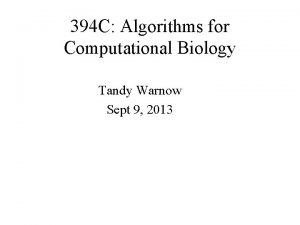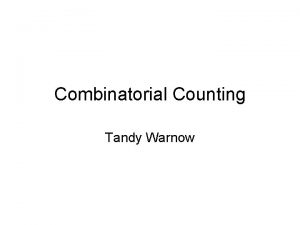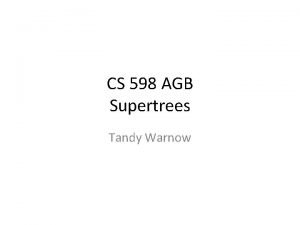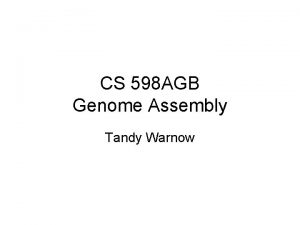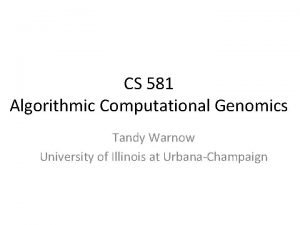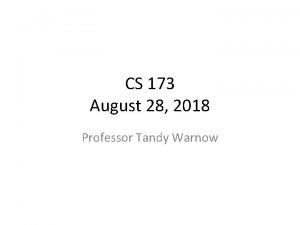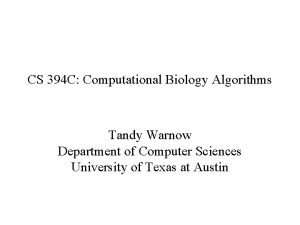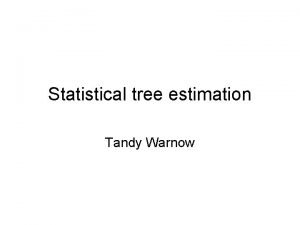CS 581 Tandy Warnow Todays material from Chapters

























- Slides: 25

CS 581 Tandy Warnow

Today’s material (from Chapters 1 -3) • Newick strings • Representing rooted trees using clades and rooted triplet trees • Constructing a rooted tree from its set of clades using Hasse Diagrams • Constructing a rooted tree from rooted triplet trees using Aho, Sagiv, Szymanski, and Ullman • Constructing a rooted tree from rooted subtrees of any size

Today’s material (from Chapters 1 -3) • Newick strings • Representing rooted trees using clades and rooted triplet trees • Constructing a rooted tree from its set of clades using Hasse Diagrams • Constructing a rooted tree from rooted triplet trees using Aho, Sagiv, Szymanski, and Ullman • Constructing a rooted tree from rooted subtrees of any size

Newick representations • For a rooted tree, we represent a graph with a string with the taxa, commas, and nested parentheses. • For example, what tree is represented by (a, (b, (c, ((d, e), (f, g))))))? • How do we represent an unrooted tree? (Easy - root it somewhere, and write down the Newick representation of the rooted version. )


Rooted vs. unrooted • Task: be able to move between rooted and unrooted representations of trees • Task: be able to compare two trees and see if they are different or the same

Today’s material (from Chapters 1 -3) • Newick strings • Representing rooted trees using clades and rooted triplet trees • Constructing a rooted tree from its set of clades using Hasse Diagrams • Constructing a rooted tree from rooted triplet trees using Aho, Sagiv, Szymanski, and Ullman • Constructing a rooted tree from rooted subtrees of any size

Clades Definition: Let T be a rooted tree leaf-labelled by S, let v an internal node in T, and let Xv be the set of leaves in T below v. Let Clades(T) = {Xv: v in V(T)}. Note: Xv is also called the “cluster” at node v, so this is sometimes called Clusters(T). • Question: Given Clades(T), can we compute T?

Triplet Trees Definition: Let T be a rooted tree leaf-labelled by S. A triplet tree is a rooted 3 -leaf subtree of T, such as ((a, b), c). The set of all triplet trees of T is denoted Triplets(T). • Question: Given Triplets(T), can we compute T?

Today’s material (from Chapters 1 -3) • Newick strings • Representing rooted trees using clades and rooted triplet trees • Constructing a rooted tree from its set of clades using Hasse Diagrams • Constructing a rooted tree from rooted triplet trees using Aho, Sagiv, Szymanski, and Ullman • Constructing a rooted tree from rooted subtrees of any size

Computing rooted trees from clades • Partially order the set of clades by containment, add in the full set S, and compute the Hasse Diagram of the resultant poset (partially ordered subset) Note: Hasse Diagrams and Partially Ordered Sets are explained in Appendix B in the textbook.

Tree construction from clades Questions: • Accuracy? • Running time? • But, how are we to compute clades?

Clade compatibility • Definition: Let T be a rooted tree leaf-labelled by S, v an internal node in T, and Xv the leaves in T below v. Let Clades(T)={Xv: v in V(T)}. • Theorem: Let X be a set of subsets of S. Then there exists a tree T such that X = Clades(T) if and only if for all A, B in X, either A and B are disjoint, or one contains the other.

Proof of theorem • One direction is easy • The other direction is a proof by construction!

Today’s material (from Chapters 1 -3) • Newick strings • Representing rooted trees using clades and rooted triplet trees • Constructing a rooted tree from its set of clades using Hasse Diagrams • Constructing a rooted tree from rooted triplet trees using Aho, Sagiv, Szymanski, and Ullman • Constructing a rooted tree from rooted subtrees of any size

Rooted Tree Compatibility • Input: Set X of rooted trees, not all on the same set of leaves. • Output: Tree T (if it exists) that agrees with all the trees in X, and otherwise “Fail” This problem is solvable in polynomial time. Proof: the Aho, Sagiv, Szymanski, and Ullman (ASSU) algorithm!

ASSU algorithm Given set X of k triplet trees on n species: • If n>1, then construct graph with each species one of the vertices, and edges (a, b) for triplets ab|c. • If the graph has a single component, reject (the set is not compatible); else recurse on each component, and return tree formed by making the rooted trees on the components each a subtree off the root of the returned tree.

Why does it work? If the set X of triplet trees is compatible, • Then there is a rooted tree T with at least two subtrees off the root, T 1 and T 2. • Any two leaves a, b in the same subtree cannot be in a triplet ab|c. • Hence the graph formed for the set of triplet trees cannot be connected. • Therefore the graph formed for the set of triplet trees must have at least two components. • This argument applies recursively to every subset of X. • Hence the algorithm returns a tree on which all the triplet trees agree. If the set X of triplet trees is not compatible, it is not hard to show that the algorithm will detect this (proof by induction on the number of taxa).

Today’s material (from Chapters 1 -3) • Newick strings • Representing rooted trees using clades and rooted triplet trees • Constructing a rooted tree from its set of clades using Hasse Diagrams • Constructing a rooted tree from rooted triplet trees using Aho, Sagiv, Szymanski, and Ullman • Constructing a rooted tree from rooted subtrees of any size

Compatibility of rooted trees • Suppose the input is a set X of rooted trees (not necessarily triplet trees). • Can we use ASSU to determine if X is compatible, and to compute a compatibility supertree for X? • Solution: YES, just encode each rooted tree in X by its set of rooted triplet trees (or some subset of these that suffices to define each tree in X), and then run ASSU.

Compatibility of rooted trees • Suppose the input is a set X of rooted trees (not necessarily triplet trees). • Can we use ASSU to determine if X is compatible, and to compute a compatibility supertree for X? • Solution: YES, just encode each rooted tree in X by its set of rooted triplet trees (or some subset of these that suffices to define each tree in X), and then run ASSU.

Compatibility of rooted trees • Suppose the input is a set X of rooted trees (not necessarily triplet trees). • Can we use ASSU to determine if X is compatible, and to compute a compatibility supertree for X? • Solution: YES, just encode each rooted tree in X by its set of rooted triplet trees (or some subset of these that suffices to define each tree in X), and then run ASSU.

Summary (so far) • We have seen how to construct a rooted tree from its set of clades or triplet trees. • We have seen how to test compatibility of a set of clades or rooted trees. How do we use these techniques for constructing unrooted trees?

Summary (so far) • We have seen how to construct a rooted tree from its set of clades or triplet trees. • We have seen how to test compatibility of a set of clades or rooted trees. Can we use these ideas to design divide-andconquer methods to construct large rooted trees?

Summary (so far) • We have seen how to construct a rooted tree from its set of clades or triplet trees. • We have seen how to test compatibility of a set of clades or rooted trees. What can we do to construct unrooted trees?
 Tandy warnow
Tandy warnow Tandy warnow
Tandy warnow Tandy warnow
Tandy warnow Tandy warnow
Tandy warnow Tandy warnow
Tandy warnow Fineboosting
Fineboosting Tandy warnow
Tandy warnow Tandy warnow
Tandy warnow Microsoft robotics developer studio tutorial
Microsoft robotics developer studio tutorial Tandy trower
Tandy trower Cpsc 581
Cpsc 581 Da form 5811 used for
Da form 5811 used for Cpsc 581
Cpsc 581 Cpsc 581
Cpsc 581 Supercom 581
Supercom 581 Cis581
Cis581 Cpsc 581
Cpsc 581 Reformatio in pejus
Reformatio in pejus 581 ad
581 ad Cis 581 upenn
Cis 581 upenn Geometric symbols and their meanings
Geometric symbols and their meanings All groups create norms to enforce their cultural values.
All groups create norms to enforce their cultural values. Idle time meaning in cost accounting
Idle time meaning in cost accounting Useful materials at home and ways to use
Useful materials at home and ways to use Forms of pop culture
Forms of pop culture Refers to the knowledge language values customs
Refers to the knowledge language values customs
